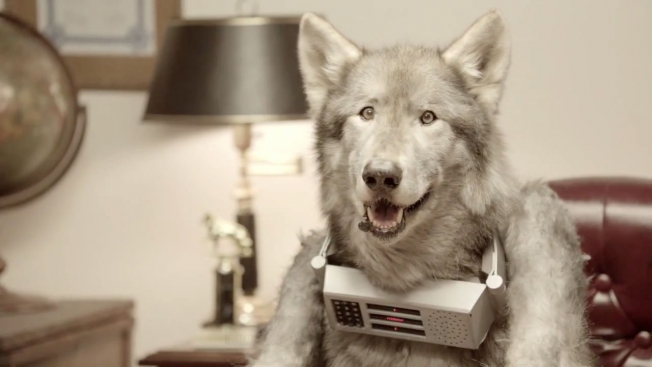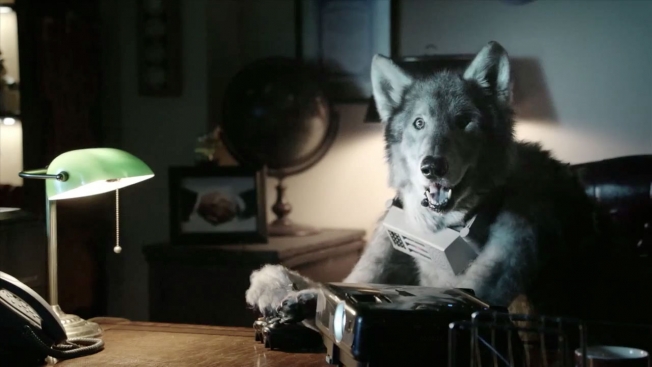![]()
In a nondescript laboratory, a stodgy scientist in a white coat fills a beaker with orange liquid. At the same time, a second beaker sitting untouched on a lab table fills up with an identical liquid—as if by magic.
This alchemical ad for Google Play’s instant data syncing must be computer-generated trickery, right? Wrong. It is a decidedly old-world illusion using a mechanical prop. Hidden under the table, engineer Eric Gradman pumps a three-plunger contraption that fills and then empties the second beaker through a tube.
While Google Play itself is effectively effortless (or so the brand maintains), constructing the custom countertop and coordinating the stunt in this ad most definitely was not. “That was 100 percent in camera,” says Jonathan Zames, writer and director of the spot. “That would have actually been easier to computer generate.”
Then why bother? “When you do it by hand, people sense all the little imperfections,” Zames explains. “It’s more surprising because they can see that real effort went into it.”
Call it artisanal advertising for the digital age. Even as pixel-driven effects get better at simulating reality, top creatives are returning to handmade techniques to pitch the less tangible offerings of tech brands such as Google, Sony, Comcast and Vizio. Aiming for authenticity, their intent is to forge emotional connections with viewers in a commercial landscape that’s increasingly saturated by computer-generated imagery.
“We live in a world of such incredible, seamless, mind-blowing special effects. There’s almost more stopping power sometimes these days in showing something that’s been done with human hands,” says Tom Murphy, chief creative officer of McCann Erickson, who oversaw “Frames,” an intricate theatrical commercial for Sony’s Xperia tablet.
From the quaint to the dramatic, ads featuring hand-built models and props stand in stark contrast to elaborate CGI fantasies pitching traditional brands such as Chevrolet, State Farm, Perrier, Old Spice, Snickers, Coca-Cola and Evian. In recent years, these and other companies have blitzed viewers with computerized apocalyptic landscapes, alien robot invasions, trips to the sun and rapid-fire, superhuman metamorphoses—not to the mention a menagerie of talking, singing and dancing babies and critters. (We mean you, Kia hamsters.)
The rise in artisanal marketing echoes Do-It-Yourself mania and the booming demand for handmade foods and goods. Online craft marketplace Etsy, for example, brokered $436.9 million in sales through the first seven months of 2012, putting it on track to sail past the $525.6 million it recorded for all of last year. The homespun buying trend dovetails with research from The Futures Company revealing that more than 80 percent of Americans believe that society is too dependent on technology and that companies have grown inhuman and impersonal.
“With technology being this overarching force in society,” says Futures vp Ryan McConnell, “people are wanting a more human touch.”
To create that human touch in a spot for Xperia, McCann Erickson took over an alleyway in Warsaw, Poland, where it installed 10-foot-high frames designed to look like oversized versions of the tablet’s screen. In the ad, a single tracking shot zooms through each “window” as actors play out real-world versions of familiar digital sequences. For instance, a pair of swordsmen clad in red are seen dicing up oversized, airborne strawberries in a reenactment of the popular video game Fruit Ninja.
To be sure, an ad depicting some guy using yet another tablet would be boring, but the magnitude of the handcrafted Xperia production featuring actors doing somersaults à la Crouching Tiger, Hidden Dragon bring to life what it might actually feel like to use the device. And rather than hiding or digitally erasing the lights, rigging and grips in the background of the shot, the creative team intentionally left them in to emphasize that the stunts were real and that the effects were “practical”—film jargon for physical.
![]() Meanwhile, the Google Play ad had to illustrate an even more abstract concept: how the cloud-computing software streamlines data files across laptops, smartphones and tablets without cables or repeated steps. A metaphoric stand-in for user content, the vanishing and reappearing orange liquid was actually Gatorade and food coloring.
Meanwhile, the Google Play ad had to illustrate an even more abstract concept: how the cloud-computing software streamlines data files across laptops, smartphones and tablets without cables or repeated steps. A metaphoric stand-in for user content, the vanishing and reappearing orange liquid was actually Gatorade and food coloring.
“There are no actual apps or music mixed into that liquid,” jokes Gradman, who helped build the table. For the shoot, he camped out beneath the counter manning the pump, aided by a folding chair and a book to stay comfortable between takes.
An artist with a master’s degree in robotics from the University of Southern California, Gradman helped create the Google spots while at Syyn Labs, a mechanically savvy design collective in Los Angeles. Splitting off from the group this spring, he and three former partners (two of whom also worked on the Google series) reformed as Two Bit Circus, which custom builds installations with technological twists. (Other founding partners include Hector Alvarez, Dan Busby and Brent Bushnell, the son of Atari and Chuck E. Cheese founder Nolan Bushnell.)
The new company’s first project is a functioning prototype of a futuristic entertainment system for retailer Best Buy, along with a reality style video series about making the half-digital, half-physical installation.
“Not only are we seeing increasing demand for practical effects, but we’re also seeing demand for people filming us making practical effects,” says Gradman, explaining that watching real people making cool things is one thing you can’t fake with software.
Of course, overall demand for practical effects isn’t what it once was.
Longtime model maker Don Bies says the amazingly lifelike CGI dinosaurs in Steven Spielberg’s 1993 film Jurassic Park were a catalyst in the rush toward computer graphics. But for some directors, the retro aesthetics of elaborate sets and models like those in films from the ’70s, ’80s and early ’90s can have a certain difficult-to-define appeal.
“There’s a cool factor” in using real props, says Bies. Now owner of White Room Artifacts, the 25-year industry veteran began his career creating mechanical puppets for David Cronenberg’s 1986 film The Fly, then moved to George Lucas’ Industrial Light and Magic’s now-defunct model shop, where he worked on films such as 1989’s Indiana Jones and the Last Crusade. (To help Nazi-aligned villain Walter Donovan’s body disintegrate in the film’s finale, Bies rigged vacuum lines that sucked a puppet’s eyeballs back into its skull.)
This year, Bies’ company built a Rube Goldberg machine in a suitcase for another Zames-directed spot for Google Play, as well as props for a Comcast ad that featured dollhouse-style miniatures inside TV monitors that actors wore on their heads. (See photos on facing page.) Following a similar concept, his team also created replicas of automobiles that replace actors’ heads in an Edmunds.com spot to illustrate the message that its employees really are “The Car People.”
Ad creatives may also be taking a cue from contemporary Hollywood directors. To announce Vizio’s entry into the personal-computing market, agency One/x hired New Deal Studios, the same model shop that built props like a Batmobile for Christopher Nolan’s The Dark Knight Rises and a steam locomotive for Martin Scorcese’s Hugo.
For the Vizio commercial, New Deal constructed a bleak, eight-foot-tall cityscape out of old computers, to frame the competition as dull and dreary, according to One/x creative director Jason Wulfsohn. Using actual parts rather than digital manipulation made the brand’s message more convincing, says Vizio media director Jason Maciel. “We just felt that building out of actual PCs and putting people into this environment made it feel authentic and real,” he explains.
Still, most if not all ads shot to look homey still get a digital finish. In the Vizio spot, for example, live actors were digitally dropped into the made-to-scale set.
There’s no doubt that consumers today expect a more polished look. A recent study of 518 consumers by visual effects software company GenArts found that purchase intent rose 12 percent when subjects were shown a Puma ad with digital burnish compared to one without.
The mix of live action with digital effects can come off like a commentary on the aesthetics of advertising. A recent Toyota spot from Saatchi & Saatchi London began with the GT86 model, captured live, driving through a digital dystopia straight out of the underworld of Grand Theft Auto. In the spot’s climax, the bright red car bursts through a wall of lights at “the end of the world,” delivering its driver from the nightmare of a computer-generated landscape into—quite literally—the greener pastures of reality.
The point was to illustrate a return to a more classic driving experience, free from the excessive gadgetry of modern cars, says Saatchi creative director Andy Jex.
As the spot’s director Adam Berg relates, the ad tells the story of someone devoid of feeling, escaping from a cold, controlled world. “For that, the CG aspect of it kind of fit the bill perfectly,” says Berg, who recently landed his feature film debut directing Universal’s remake of Cronenberg’s 1983 horror flick Videodrome. (The plot, appropriately, explores the impact of media and technology on the mind.)
Jex insists the Toyota commercial wasn’t intended as a meta critique of advertising itself. Yet it is easy to see it as a commentary on the industry’s increasing dependence on computer gimmickry.
Setting aside whether the reliance on digital spectacle threatens to become a crutch for weak messaging, digital-heavy effects continue to dominate—often to compelling effect. In a recent spot for railroad company Norfolk Southern, agency RP3 conjured a charming, Toy Story-style world in a young boy’s bedroom. After his playthings come alive and jump aboard his chugging steam engine, the voiceover intones: “Wherever our trains go, the economy comes to life.”
Just five years ago, such detailed animation would have been unrealistic under most marketing budgets and timetables.
“CGI-driven jobs are becoming more accessible purely because computers get faster and there’s more and more talent out there,” says Ben Smith, a creative director at top postproduction house The Mill, which worked on the Norfolk Southern commercial. “It all points toward being able to do more in less time, essentially.”
Still, the 60-second Norfolk Southern spot required 1,000 odd man-hours of animation work among six artists. That’s not counting design, compositing and other aspects of the production. Overall, the project took around three months to complete, says Smith—longer than usual due to the intensive nature of conceiving and designing the characters.
“The range of what we’re being asked to do is always expanding,” says CEO Robin Shenfield. He estimates that The Mill gets 90 percent of its revenue from advertising work and employs 700 people—the biggest the company has been since 2002 when it shrunk its division focused on feature films.
Still, Shenfield says, much of the company’s work aims to be photorealistic—or in lay terms, not obviously manipulated. “The whole idea there is to conspire with our clients to give the impression we’ve done absolutely nothing at all,” he explains.
Comparing practical versus digital costs is not easy since production budgets vary widely depending on project size, scope and quality. Given the intensive labor involved in creating digital graphics, it might cost around $200,000 to produce a scene with computers that would cost $50,000 to build by hand, according to estimates. For example, Comcast’s TV monitors cost about $30,000 to build, says Bies. “Let’s put it this way: Plumbers charge a lot more money than we do,” he says. “I wish I made $150 for an hour and a half.”
Expense aside, computer-generated imagery sometimes just falls short.
To promote Unilever’s Axe line of hair products, BBH executive creative director Ari Weiss and his team created a spot featuring two puppets: one a blob of shaggy men’s hair, the other a headless, cleavage-flaunting female torso. The agency enlisted Jim Henson’s Creature Shop of Muppets fame, Weiss says, because it is “notoriously difficult” to create natural-looking locks using computer graphics.
Though handmade effects may be in vogue, Weiss doesn’t necessarily expect the trend to last.
“Creatives are incredibly fickle folks: We like the new toys...and then a new toy comes out,” he says.
So what’s the next big thing? “That’s the million dollar question,” says Weiss.
Maybe better hair.




 Meanwhile, the Google Play ad had to illustrate an even more abstract concept: how the cloud-computing software streamlines data files across laptops, smartphones and tablets without cables or repeated steps. A metaphoric stand-in for user content, the vanishing and reappearing orange liquid was actually Gatorade and food coloring.
Meanwhile, the Google Play ad had to illustrate an even more abstract concept: how the cloud-computing software streamlines data files across laptops, smartphones and tablets without cables or repeated steps. A metaphoric stand-in for user content, the vanishing and reappearing orange liquid was actually Gatorade and food coloring.







 Starbucks
Starbucks Burger King
Burger King Oreo
Oreo Red Bull
Red Bull Samsung
Samsung JetBlue
JetBlue Old Spice
Old Spice Axe
Axe Pine-Sol
Pine-Sol Taco Bell, Doritos
Taco Bell, Doritos











